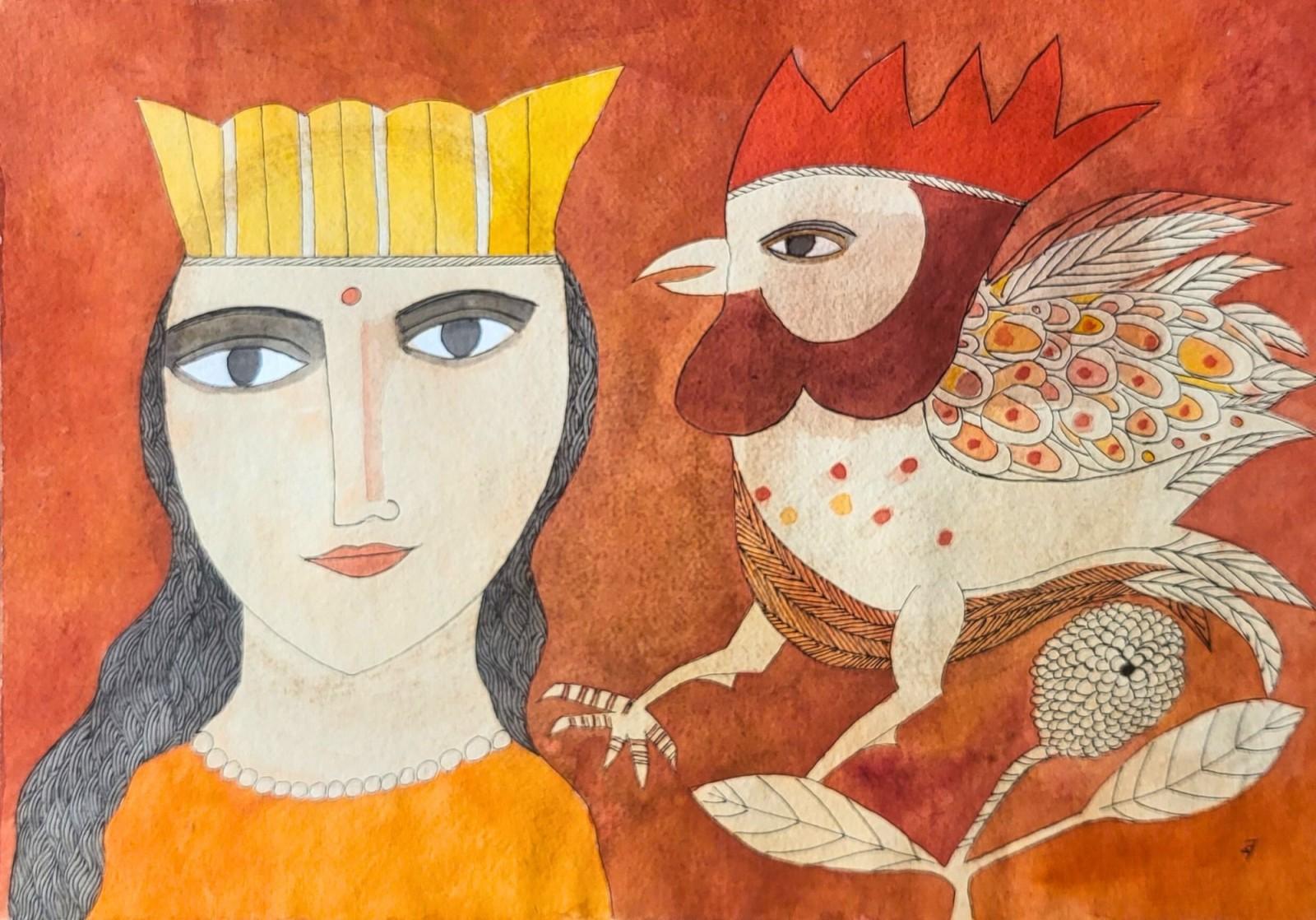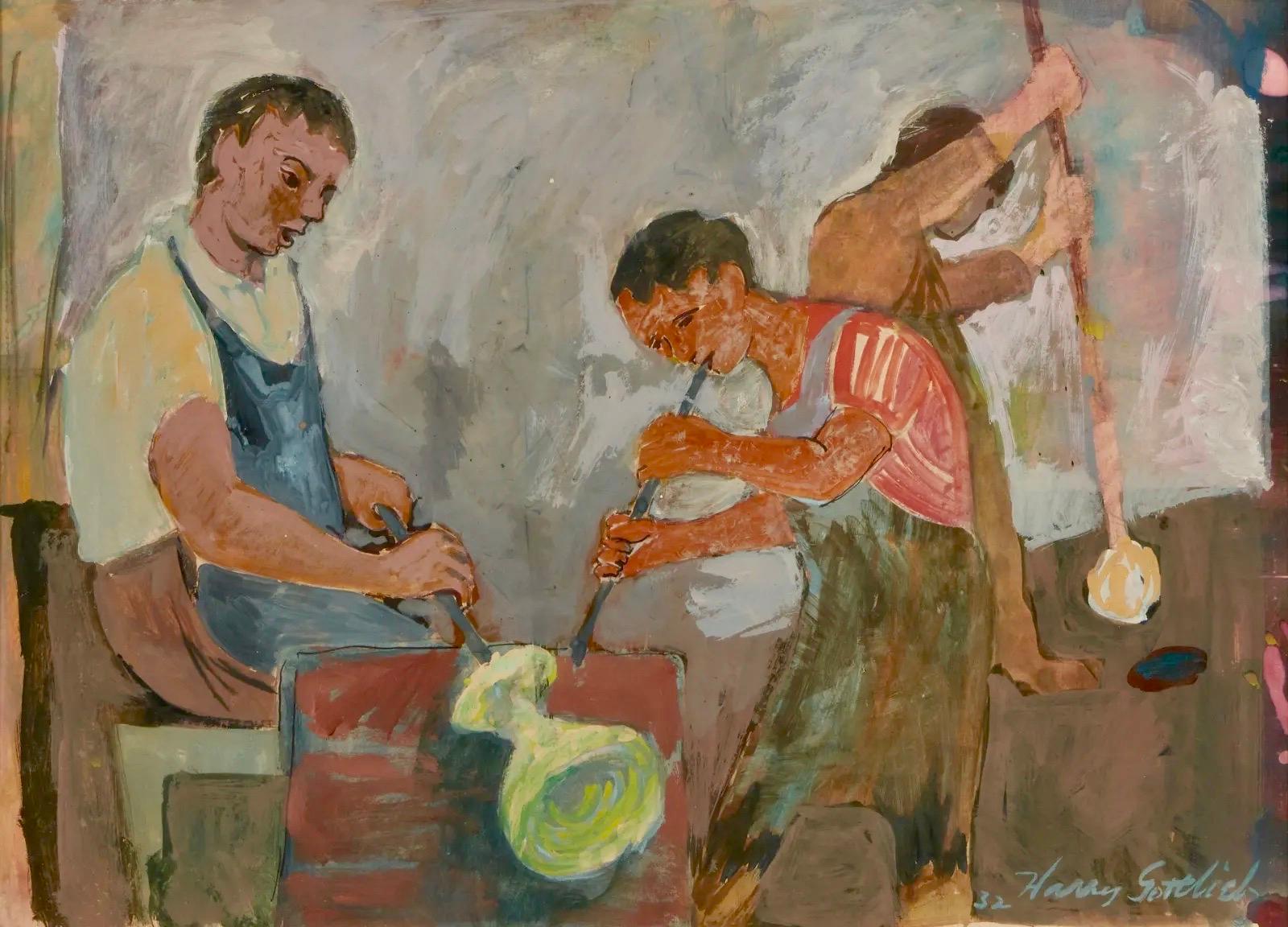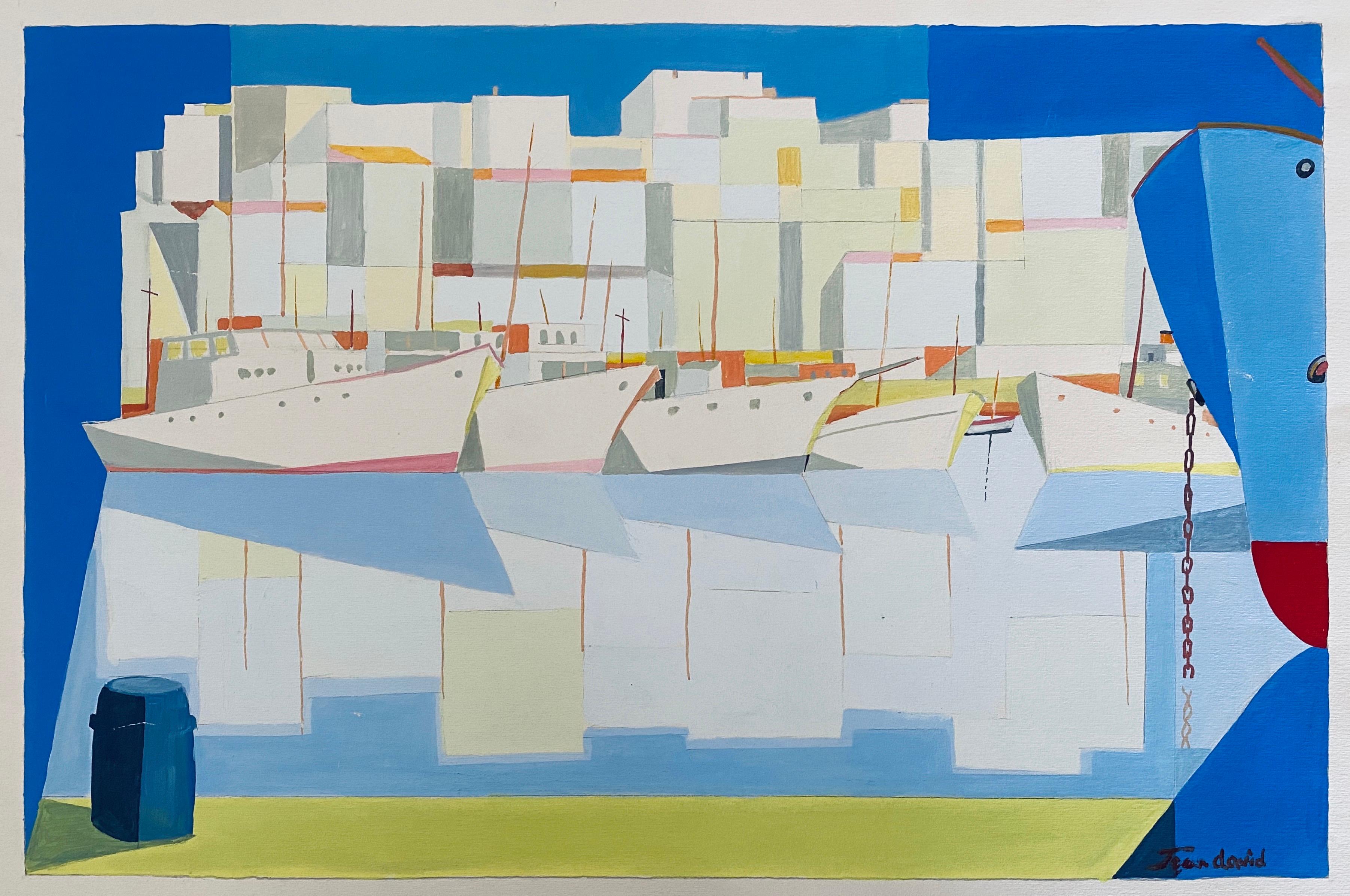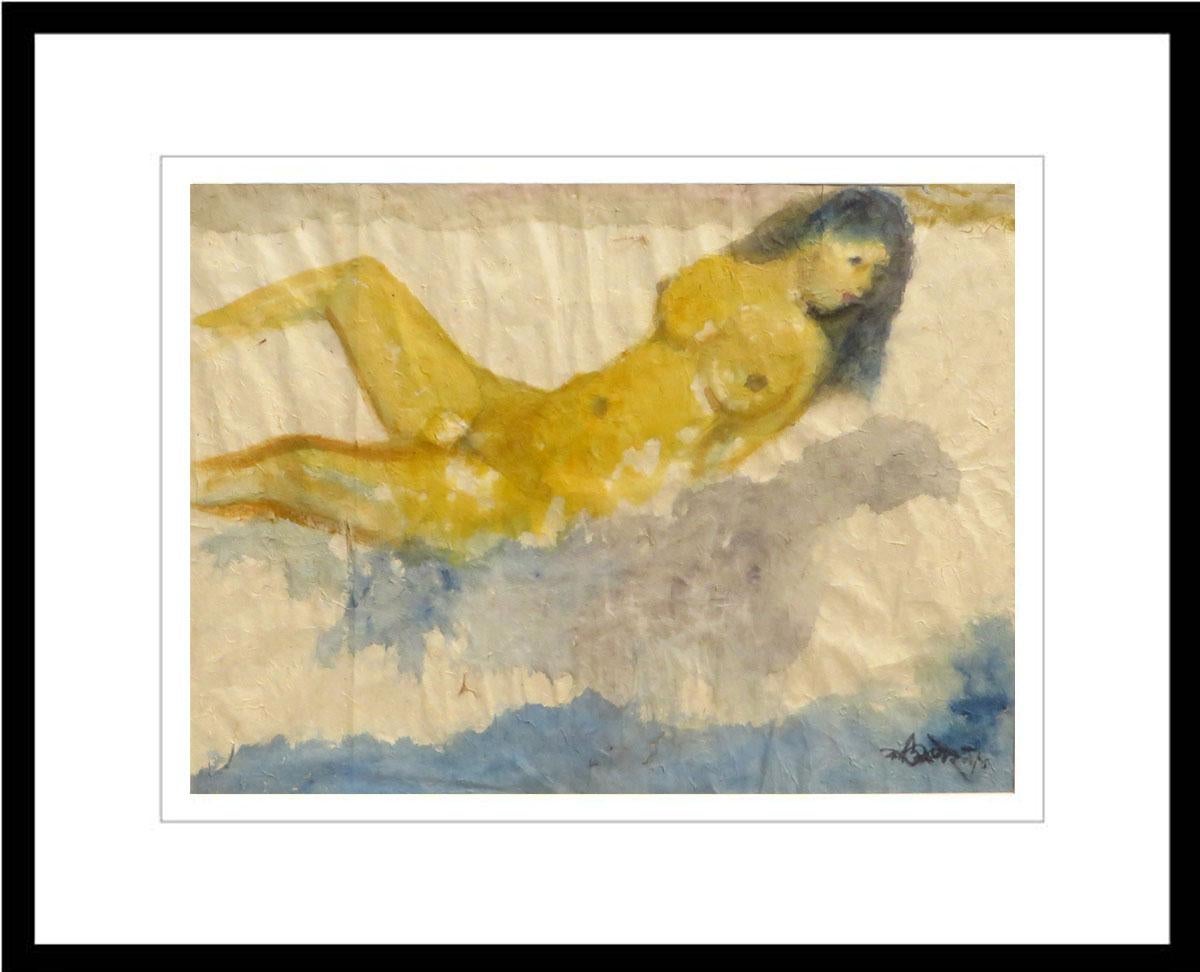Items Similar to Theater Spain. Paper, mixed media, 9.7x8.3 cm
Want more images or videos?
Request additional images or videos from the seller
1 of 3
Adolfs ZardinsTheater Spain. Paper, mixed media, 9.7x8.3 cm
About the Item
Theater Spain. Paper, mixed media, 9.7x8.3 cm
watercolor, ink on paper.
Adolfs Zardins
(1890 08 II Riga, Latvia – 1967 07 II Jurmala, Latvia), painter.
Only in 1990 his relatives give his artistic heritage to publicity.
“I am 58, and in five Years my colors and lines will be genuinely perfect…”
“I don’t obey anything expert myself and my time…”
His works are full of classic themes (history, mythology, religion and erotic's) but interpretation is paradoxical, associative, allegoric and also subjective. Zardins in his works created so-called “individual mythology”.
Exhibitions:
1931, 1933 and 1935 – group exhibitions of the Union of the Independent Artists;
Memorial exhibitions:
1998 – Riga;
1999 – Germany (Veclara)
1999 – Moscow, Pushkin State Museum of Fine Arts.
2006 – Italy
2019 - In Bucharest, at the main building of the Titulescu Foundation
- Creator:Adolfs Zardins (1890 - 1967)
- Dimensions:Height: 3.82 in (9.7 cm)Width: 3.27 in (8.3 cm)Depth: 0.04 in (1 mm)
- Medium:
- Movement & Style:
- Period:
- Condition:
- Gallery Location:Riga, LV
- Reference Number:1stDibs: LU143727178262
About the Seller
5.0
Platinum Seller
These expertly vetted sellers are 1stDibs' most experienced sellers and are rated highest by our customers.
Established in 2002
1stDibs seller since 2020
144 sales on 1stDibs
Typical response time: 8 hours
- ShippingRetrieving quote...Ships From: Riga, Latvia
- Return PolicyA return for this item may be initiated within 7 days of delivery.
More From This SellerView All
- Excitation. 1960, paper, mixed media, 14x10 cmLocated in Riga, LVExcitation. 1960, paper, mixed media, 14x10 cm Adolfs Zardins (1890 08 II Riga, Latvia – 1967 07 II Jurmala, Latvia), painter. Only in 1990 his relative...Category
Late 20th Century Modern Figurative Paintings
MaterialsPaper, Mixed Media, Watercolor
- Mirror. Paper, mixed media, 10x14 cmLocated in Riga, LVMirror. Paper, mixed media, 10x14 cm Adolfs Zardins (1890 08 II Riga, Latvia – 1967 07 II Jurmala, Latvia), painter. Only in 1990 his relatives give his artistic heritage to publici...Category
Late 20th Century Modern Figurative Paintings
MaterialsPaper, Mixed Media, Watercolor
- Erotic motives. 2.pcs., paper, cardboard, mixed media, 7, 7x3 cm, 5x5 cmLocated in Riga, LVErotic motives. 2.pcs., paper, cardboard, mixed media, 7,7x3 cm, 5x5 cm small two drawings with erotic motives Adolfs Zardins (1890 08 II Riga, Latvia – 1967 07 II Jurmala, Latvia),...Category
Late 20th Century Modern Figurative Paintings
MaterialsPaper, Watercolor, Cardboard
- Erotic motives. 3.pcs., paper, mixed media, 12, 6x4, 3 cm, 6, 1x3, 2 cm, 6, 9x3, 2 cmLocated in Riga, LVErotic motives. 3.pcs., paper, mixed media, 12,6x4,3 cm, 6,1x3,2 cm, 6,9x3,2 cm small three drawings with erotic motives Adolfs Zardins (1890 08 II Riga...Category
Late 20th Century Modern Figurative Paintings
MaterialsPaper, Watercolor, Mixed Media
- From the circus. Cardboard, mixed media, 9.4x8 cmLocated in Riga, LVFrom the circus. Cardboard, mixed media, 9.4x8 cm watercolor, ink on paper. Adolfs Zardins (1890 08 II Riga, Latvia – 1967 07 II Jurmala, Latvia), painter. Only in 1990 his relative...Category
1930s Modern Figurative Paintings
MaterialsPaper, Watercolor
- At night. Paper, mixed media, 14.5x8 cmLocated in Riga, LVAt night. Paper, mixed media, 14.5x8 cm watercolor, ink on paper. Adolfs Zardins (1890 08 II Riga, Latvia – 1967 07 II Jurmala, Latvia), painter. Only in 1990 his relatives give his...Category
1930s Modern Figurative Paintings
MaterialsPaper, Watercolor
You May Also Like
- The Cockerel, Water colour on Paper Grey, Red by Indian Artist"In Stock"By Badri NarayanLocated in Kolkata, West BengalBadrinarayan The Cockerel Water colour on Paper 22 x 14 inches 55.8 x 35.5 cm This work features in the Book on Badrinarayan Written by Ms. Prema Vishwanathan & Published by Ma...Category
20th Century Modern Figurative Paintings
MaterialsPaper, Watercolor
- Glassblowers WPA American Scene Mid- 20th Century Modern Figurative Workers 1932By Harry GottliebLocated in New York, NYGlassblowers WPA American Scene Mid- 20th Century Modern Figurative Workers. Dated and signed "32 Harry Gottlieb" lower right. Sight: 13 1/8" H x 18 1/4" W. Harry Gottlieb, painter, screenprinter, educator, and lithographer, was born in Bucharest, Rumania. He emigrated to America in 1907, and his family settled in Minneapolis. From 1915 to 1917, Gottlieb attended the Minneapolis Institute of Arts. After a short stint as an illustrator for the U.S. Navy, Gottlieb moved to New York City; he became a scenic and costume designer for Eugene O"Neill's Provincetown Theater Group. He also studied at the Philadelphia Academy of Fine Arts and the National Academy of Design. He was one of America's first Social Realist painters, influenced by that Robert Henri-led movement in New York City where Gottlieb settled in 1918. He was also a pioneer in screen printing, which he learned while working for the WPA. He married Eugenie Gershoy, and the couple joined the artist colony at Woodstock, New York. He lectured widely on art education. In 1923, Gottlieb settled in Woodstock, New York and in 1931, spent a a year abroad studying under a Guggenheim Fellowship. In 1935, he joined the Federal Art Project...Category
1930s American Modern Figurative Paintings
MaterialsPaper, Gouache
- Romanian Modernist Gouache Painting Of Buildings And Boats - Jean DavidBy Jean DavidLocated in Surfside, FLJean David was a painter and designer, known for his contributions to the Romanian avant-garde and to the early modernist art of Israel (then recently founded). He was the first Israeli artist to be inducted into the illustrious Alliance Graphique Nationale in 1954. He had studied between 1927 and 1937 at various art academies in Paris. In 1929 he participated for the first time at a collective exhibition in Bucharest and in 1933 he had his first personal exhibition (in the same city). In the early '30s he was a member of the Surrealist group "unu" (meaning "one"). In 1942, he left Romania in a boat with 12 other Jews, including Theodor Brauner, the brother of Victor Brauner. After being captured by British authorities in Cyprus, he managed to reach Palestine in 1944. In 1949 he went to live in Jerusalem, where he was active in developing ceramic arts, sculpture works in copper, and artistic tapestry wall hangings under the auspices of the Ministry of Trade and Industry. Together with Marcel Janco, he founded in Israel the artist village known as Ein Hod. He also gained much reputation as a muralist and graphic and poster designer, having designed numerous posters and other works for the El Al air company, Maccabiah games, Zim shipping and The Israel tourist industry. David’s primary importance was in the design of posters. He used a wildly colorful decorative style in his art, which combined illustration, caricature, and national figures. In addition he designed wall hangings for “Maskit,” and also worked in the decoration of public buildings. His paintings had elements of Surrealism and included images from nature and landscapes. Similar in style to David Klein and the Polish Cyrk posters. Forms From Israel, Mounting Exhibition, USA, 1958 Artists: El Hanani (Sapozhnikow), Arie Azaz, Nehemiah Boris Carmi, Hanna Harag Zunz, David, Jean David Gumbel, Keiner Forcheimer, Julia Mansfeld, Al Merom, Peter Mayer, Jean Palombo...Category
Mid-20th Century Modern Figurative Paintings
MaterialsGouache, Paper
- Chicago Jewish Modernist Judaica Painting Simchat Torah WPA Artist Israeli FlagsBy Alexander Raymond KatzLocated in Surfside, FLThis has young ISraeli pioneers dancing with the flag as typical of works of the late British mandate Palestine era early state of Israel. Genre: Modern Subject: Figurative (stained glass style) Medium: Mixed media gouache on paper Hand signed lower left Alexander Raymond Katz, Hungarian / American (1895 – 1974) Alexander Raymond Katz was born in Kassa, Hungary, and came to the United States in 1909. He studied at the Art Institute of Chicago and the Chicago Academy of Fine Arts. In the late 1920s, he worked as a director of the Poster Department at Paramount Studios. He was appointed the Director of Posters for the Chicago Civic Opera in 1930. During the Great Depression, notable architect Frank Lloyd Wright urged Katz to become a muralist. In 1933, he was commissioned to paint a mural for the Century of Progress exposition in Chicago. In 1936, he painted the mural History of the Immigrant for the Madison, Ill., post office. Katz’s works were included in various exhibitions and now are part of several museum collections, including those of the Art Institute of Chicago; Corcoran Gallery of Art, Washington, D.C.; and the Jewish Museum, New York. His murals, bas-reliefs and stained glass designs adorn more than 200 Jewish synagogues in the United States. Katz and other Jewish artists in Chicago who expressed Jewish and Biblical themes were inspired by the artist Abel Pann (1883-1963). Pann, who is regarded as the leading painter of the Land of Israel, exhibited in the Art Institute of Chicago in 1920. Early in his career, Katz began to explore the artistic possibilities inherent in the characters of the Hebrew alphabet. He developed aesthetic and philosophical interpretations of each letter and became the leading innovator and pioneer in the field of Hebraic art. Katz applies this concept in the woodcut Moses and the Burning Bush. Hebrew letters appears in Moses’ head, his cane and inside the flame. The initial of Moses’ name crowns his head. The letter in the flame is the first letter of the name of God. A combination of images and Hebrew letters appeared commonly in illustrations of the scene Moses and the Burning Bush in the Haggadah, the book of Passover. The symbolism of the burning bush corresponds to the motifs of A Gift to Biro-Bidjan. Among the fourteen participating artists were notable Chicago modernists Todros Geller, Mitchell Siporin...Category
Mid-20th Century Modern Figurative Paintings
MaterialsPaper, Gouache
- Rare Modernist Hungarian Rabbi Pastel Drawing Gouache Painting Judaica Art DecoBy Hugó ScheiberLocated in Surfside, FLRabbi in the synagogue at prayer wearing tallit and tefillin. Hugó Scheiber (born 29 September 1873 in Budapest – died there 7 March 1950) was a Hungarian modernist painter. Hugo Scheiber was brought from Budapest to Vienna at the age of eight where his father worked as a sign painter for the Prater Theater. At fifteen, he returned with his family to Budapest and began working during the day to help support them and attending painting classes at the School of Design in the evening, where Henrik Papp was one of his teachers. He completed his studies in 1900. His work was at first in a post-Impressionistic style but from 1910 onward showed his increasing interest in German Expressionism and Futurism. This made it of little interest to the conservative Hungarian art establishment. However, in 1915 he met the great Italian avant-gardist Filippo Tommaso Marinetti and the two painters became close friends. Marinetti invited him to join the Futurist Movement. The uniquely modernist style that he developed was, however, closer to German Expressionism than to Futurism and eventually drifted toward an international art deco manner similar to Erté's. In 1919, he and his friend Béla Kádar held an exhibition at the Hevesy Salon in Vienna. It was a great success and at last caused the Budapest Art Museum to acquire some of Scheiber's drawings. Encouraged, Scheiber came back to live in Vienna in 1920. A turning point in Scheiber's career came a year later, when Herwarth Walden, founder of Germany's leading avant-garde periodical, Der Sturm, and of the Sturm Gallery in Berlin, became interested in Scheiber's work. Scheiber moved to Berlin in 1922, and his paintings soon appeared regularly in Walden's magazine and elsewhere. Exhibitions of his work followed in London, Rome, La Paz, and New York. Scheiber's move to Germany coincided with a significant exodus of Hungarian artists to Berlin, including Laszlo Moholy-Nagy and Sandor Bortnyik. There had been a major split in ideology among the Hungarian avant-garde. The Constructivist and leader of the Hungarian avantgarde, Lajos Kassák (painted by Hugó Scheiber in 1930) believed that art should relate to all the needs of contemporary humankind. Thus he refused to compromise the purity of his style to reflect the demands of either the ruling class or socialists and communists. The other camp believed that an artist should be a figurehead for social and political change. The fall out and factions that resulted from this politicisation resulted in most of the Hungarian avant gardists leaving Vienna for Berlin. Hungarian émigrés made up one of the largest minority groups in the German capital and the influx of their painters had a significant effect on Hungarian and international art. Another turning point of Scheiber's career came in 1926, with the New York exhibition of the Société Anonyme, organized by Katherine Dreier. Scheiber and other important avant garde artists from more than twenty-three countries were represented. In 1933, Scheiber was invited by Marinetti to participate in the great meeting of the Futurists held in Rome in late April 1933, Mostra Nazionale d’Arte Futurista where he was received with great enthusiasm. Gradually, the Hungarian artists began to return home, particularly with the rise of Nazism in Germany. Kádar went back from Berlin in about 1932 and Scheiber followed in 1934. He was then at the peak of his powers and had a special flair in depicting café and cabaret life in vivid colors, sturdily abstracted forms and spontaneous brush strokes. Scheiber depicted cosmopolitan modern life using stylized shapes and expressive colors. His preferred subjects were cabaret and street scenes, jazz musicians, flappers, and a series of self-portraits (usually with a cigar). his principal media being gouache and oil. He was a member of the prestigious New Society of Artists (KUT—Képzőművészek Új Társasága)and seems to have weathered Hungary's post–World War II transition to state-communism without difficulty. He continued to be well regarded, eventually even receiving the posthumous honor of having one of his images used for a Russian Soviet postage stamp (see image above). Hugó Scheiber died in Budapest in 1950. Paintings by Hugó Scheiber form part of permanent museum collections in Budapest (Hungarian National Museum), Pecs (Jannus Pannonius Museum), Vienna, New York, Bern and elsewhere. His work has also been shown in many important exhibitions, including: "The Nell Walden Collection," Kunsthaus Zürich (1945) "Collection of the Société Anonyme," Yale University Art Gallery, New Haven, Connecticut (1950) "Hugó Scheiber: A Commemorative Exhibition," Hungarian National Museum, Budapest (1964) "Ungarische Avantgarde," Galleria del Levante, Munich (1971) "Paris-Berlin 1900-1930," Centre Georges Pompidou, Paris (1978) "L’Art en Hongrie, 1905-1920," Musée d’Art et l’Industrie, Saint-Etienne (1980) "Ungarische Avantgarde in der Weimarer Republik," Marburg (1986) "Modernizmus," Eresz & Maklary Gallery, Budapest (2006) "Hugó Scheiber & Béla Kádár," Galerie le Minotaure, Paris and Tel Aviv (2007) Hugó Scheiber's paintings continue to be regularly sold at Sotheby's, Christie's, Gillen's Arts (London), Papillon Gallery (Los Angeles) and other auction houses. He was included in the exhibition The Art Of Modern Hungary 1931 and other exhibitions along with Vilmos Novak Aba, Count Julius Batthyany, Pal Bor, Bela Buky, Denes Csanky, Istvan Csok, Bela Czobel, Peter Di Gabor, Bela Ivanyi Grunwald, Baron Ferenc Hatvany, Lipot Herman, Odon Marffy, C. Pal Molnar...Category
Early 20th Century Modern Figurative Paintings
MaterialsPaper, Charcoal, Pastel, Watercolor, Gouache
- Nude Woman Bathing, Reclining, Watercolor, Blue, Yellow by K.C. Pyne "In Stock"By Kartick Chandra PyneLocated in Kolkata, West BengalKartick Chandra Pyne - Untitled - 18 x 29 inches ( unframed size without mount ) Watercolor on rice paper Signed in Bengali Lower right. This would will be shipped mounted without th...Category
Early 2000s Modern Nude Paintings
MaterialsPaper, Rice Paper, Watercolor





